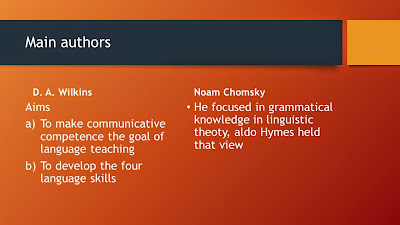miércoles, 22 de abril de 2015
REFLECTION ABOUT SKILLS DEVELOPMENT
All the course is about the way to develop skills and I think teaching is difficult because we have to found ways for learning of students.
The course was developed with readings and for me this was difficult because there was vocavulary that I didn´t understand.
But the activities whit children was very important because I understood the way that children learn and also I discovered that they have different ways for learning.
Finally about me I feel that I was nervous becacause I felt fearfully so I din´t participate a lot.
Thank you teacher for your teaching.
lunes, 20 de abril de 2015
SPEAKING DEFNITIONS
SKILLS DEVELOPMENT
SPEAKING DEFNITIONS
1.- It is defined as a process of building and sharing meaning through the use of verbal or oral form (Chaney, 1978 and Gebhard, 1996)
2.- Speaking consists in producing systematic verbal utterances in convey meaning (Numan, 2003)
3.- Speaking is the actions of conveying information or expressing one´s thoughts and feelings in spoken language (Oxfor University)
4.- Speaking is described as an interactive process of constructing meaning that involves producing and receiving and processing information. Speaker requires to know about specofic points of lnguage such as grammar, pronunciation, or vocabulary.
5.- Vygotsky a psychological system (1997, p. 92) concetrated his research on unification as a process which includes babbling, attending to sound, using the pointing gesture as a symbol representing intent and generalization.
1.- It is defined as a process of building and sharing meaning through the use of verbal or oral form (Chaney, 1978 and Gebhard, 1996)
2.- Speaking consists in producing systematic verbal utterances in convey meaning (Numan, 2003)
3.- Speaking is the actions of conveying information or expressing one´s thoughts and feelings in spoken language (Oxfor University)
4.- Speaking is described as an interactive process of constructing meaning that involves producing and receiving and processing information. Speaker requires to know about specofic points of lnguage such as grammar, pronunciation, or vocabulary.
5.- Vygotsky a psychological system (1997, p. 92) concetrated his research on unification as a process which includes babbling, attending to sound, using the pointing gesture as a symbol representing intent and generalization.
Synthesis of CLT COMMUNICATIVE LANGUAGE TEACHING
COMMUNICATIVE
LANGUAGE TEACHING CLT is an approach which includes theory according to
the learning styles; also it is view as a resource to develop the communicative
competence. This approach contains a great variety of activities inside the
classroom
COMUNICATIVE LANGUAGE TEACHING
The goal of language teaching.
LT aims to teach communicative
competence of which this includes several aspects, such as:
·
Knowing how to use language for a range of different purposes and
functions
·
Knowing how to vary our use of language according to the setting and the
participants (e.g., knowing when to use formal and informal speech or when to
use language appropriately for written as opposed to spoken communication)
·
Knowing how to produce and understand different types of texts
(e.g., narratives, reports, interviews, conversations)
·
Knowing how to maintain communication despite having limitations in
one’s language knowledge (e.g., through using different kinds of communication
strategies).
The Roles of
Teachers and Learners in the Classroom
CLT implied new roles in the
classroom for teachers and learners. Learners now have to participate in
classroom activities that are based on a cooperative rather than
individualistic approach to learning. Students had to become comfortable with
listening to their peers in group work or pair work tasks, rather than relying
on the teacher for a model. They need to take on a greater degree of
responsibility for their own learning. And teachers now have to assume the role
of facilitator and monitor, rather than being a model. They have develop a
different view of learners’ errors and of her/his own role in facilitating
language learning either.
What activities
best fascilitate learning?
Accuracy vs fluency activities;
mechanical, meaningful, and communicative practice; information-gap activities;
jigsaw activities; emphasis on pair and grop work, authenticity practice.
Suscribirse a:
Entradas (Atom)























